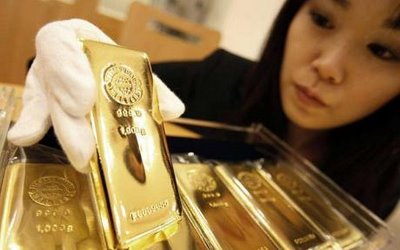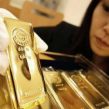
China Assesses its Gold Reserve Strategy
Publication: China Brief Volume: 10 Issue: 5
By:

As the U.S. economy dithers through a fragile global recovery, Chinese leaders are convening in Beijing for the annual plenary session of the National People’s Congress (NPC)—China’s ceremonial legislature—that begins March 5. The purpose of the meeting is to "hammer" out, among other things, a blueprint for the Renminbi’s (or Yuan) ascendancy. China’s 2010 economic blueprint, which was officially unveiled at the plenary’s opening, set the country’s target growth rate to the proverbial 8 percent—which is the rate Chinese economists deem sufficient to generate enough domestic demand to make up for dwindling exports to regions such as the United States and Europe. The 8 percent growth target has remained the same since 2004 and is also widely seen as politically necessary to create enough jobs to stave off social unrest. While the world’s largest economy—United States—struggles to stem the bleeding of jobs in its ailing economy, its biggest creditor—China—has been quietly increasing its gold reserves in an apparent effort to hedge the weakening value of the U.S. dollar and stabilize the value of its massive foreign exchange (FOREX) reserves. Depending on the pace and scope of China’s FOREX reserves diversification strategy, this trend will have broad implications for the internationalization of the Renminbi (RMB) and China’s $2.27 trillion FOREX reserves that are mostly parked in U.S. treasuries.
One of the key issues that Chinese leaders will have to tackle is whether to let the RMB rise to restructure the domestic economy and rebalance the global economy. If Chinese leaders decide to allow the RMB to appreciate against the dollar and other currencies, gold may increasingly become an attractive alternative to include within the ‘basket’ of China’s FOREX reserves. As one of the world’s largest holder of U.S. treasury bills—the general estimate is that China owns close to one trillion dollars of U.S. Treasury securities—senior Chinese leaders have become more vocal in expressing their concerns over the United States’ fiscal discipline and calling for an alternative international reserve currency. From the outset of 2009, Beijing has taken pains to diversify its monetary risks, which include signing multiple bilateral currency swaps and actively pushing for the restructuring of international financial institutions. Another instrument less discussed in mainstream analysis, but has long term implications for the viability of the dollar as the universal reserve currency, can be gleaned from the fact that in 2009 China reportedly bought 454.1 tons of gold from its domestic market, which is equivalent to nearly 50 percent of the total purchases of 890 tons of gold made by the world’s central banks in the same year (China Review News, December 30, 2009).
In 2009, citing the head of the State Administration of Foreign Exchange (SAFE), Hu Xiaolian, the official-Xinhua News Agency reported that China increased its gold reserves by 76 percent in six years (2003) to 1,054 tons (China Daily, April 24, 2009). By comparison, the U.S. gold reserves totaled 8133.5 tons in September 2008, accounting for 76.5 percent of its total FOREX reserves. While Japan’s 765.2 tons accounted for 1.9 percent of its total FOREX reserves. China’s holdings of 1,054 tons of gold make up about 1.2 percent of its total FOREX reserves (Market Watch, March 3; United Daily News [Taiwan], February 24).
An unconfirmed 2008 report from a Guangzhou-based newspaper, Guangzhou Daily, reported that China’s central bank was considering to raise its gold reserve by 4,000 metric tons from the then-600 tons to diversify risks brought by the country’s huge FOREX reserves, which is largely based on T-bills (Dow Jones Newswire, November 19, 2008). Another report in mid-2009, which cited the chair of the supervisory board for big state-owned companies under the Chinese State Council’s state assets commission, Ji Xiaonan, reported that "China’s gold reserves should reach 6,000 tons in the next 3-5 years and perhaps 10,000 tons in 8-10 years" (China Post, December 1, 2009).
According to statistics released by the World Gold Council (WGC)—an industry association of the world’s leading gold mining companies—in 2007, China surpassed South Africa as the world’s largest gold producer, and in 2009, China surpassed India as the world’s largest consumer of gold (China Economic Net, February 4). While China bought nearly 50 percent of the total gold purchases by central banks in 2009, the volume of China’s gold reserve in terms of its FOREX reserves only ranks fifth in the world, and is well below the global average. According to some experts, in light of the uncertainty posed by the global financial crisis, as a large FOREX reserves holder with a small gold reserve, China’s FOREX reserve is at risk and the stability of its value is in question. Thus, increasing China’s gold reserve is critically important for the currency’s long-term prospect and the country’s comprehensive national strength (United Daily News, February 24).
A senior official from the People’s Bank of China (PBoC) suggested, "China should formulate a long-term plan and constantly and secretly increase its gold holdings, claiming that at present the percentage of gold in China’s total reserve was too low … PBoC should try to buy as much gold as possible from China’s annual gold output of almost 300 tons, while the gold needed by industries and residents could be imported” (China Stakes, April 27, 2009).
Since the International Monetary Fund (IMF) announced its plans to sell 191.3 metric tons of gold on February 17, which is a part of its decision to sell off 1/8 of its holdings of a total volume limited to 403.3 metric tons, there have been speculations galore about whether China would purchase the remaining lot. The IMF has not officially commented on the prospect (United Daily News, February 24; Economic Daily News [Taiwan], March 2). Soon after India (and Sri Lanka) bought IMF gold in late 2009, Wei Benhua, former deputy head of SAFE, said in an interview with the reputable Chinese-business journal Caijing that, “At present we should not buy. Instead we should wait for the IMF to sell gold next time, when the price of gold drops to a relatively low level …” (Caijing, November 2009). Although Chinese leaders may have avoided buying from the international gold market before to steer clear of triggering market fluctuation, there is clearly a growing chorus that supports abandoning this conservative strategy.
According to Xia Bin, the director of the Financial Research Institute of the Chinese State Council—the Chinese government’s executive branch—China should continue long-term buying of gold and take advantage of when the international price is low to increase the volume of China’s gold reserves, which will help strengthen the position of the RMB as an international reserve currency and China’s long term economic development. Furthermore, Xia and other Chinese economists recommended that China allow its private enterprises to purchase gold from the international market (Economic Daily News, March 2; Money.163.com, February 26). In either case, the long-term implications of Chinese debates to increase its gold reserves will have far-reaching impact on the stability of China’s FOREX reserves and the RMB’s position of becoming the next reserve currency of the world—the question for Chinese leaders now appears no longer if but how.





